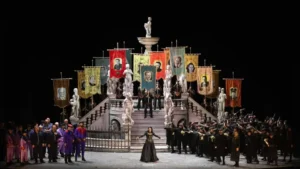
Teatro San Carlo 2023-24 Review: I Vespri Siciliani
By Laura ServideiVerdi’s “I Vespri Siciliani” was last on the stage in Naples back in 2011, featuring the original French version created by the composer for the Opera de Paris in 1855. This year, however, Teatro San Carlo is showcasing the Italian rendition, which is more commonly performed in Italy, without the ballet sequences.
The narrative, crafted by Eugene Scribe’s libretto, revolves around the historical upheavals of 1282, when the populace of Palermo rose against French occupation, igniting a revolution that spread throughout Sicily, ultimately liberating the island from Angevin rule that endured for two decades.
Honor to the Fallen From Mafia Violence
Director Emma Dante has contemporized the setting, shifting the backdrop from the 13th century to the present day, where the oppressors transition from French invaders to the modern-day mafia. Soldiers don bright-colored acetate tracksuits, while civilians don traditional black attire. The costume design is by Vanessa Sannino. The central character, Duchess Elena, originally seeks vengeance for her brother Federigo executed by the French ruler. Dante reimagines her as Rita Borsellino, who became an anti-mafia activist and politician when her brother Paolo, a famous judge, was murdered by the mafia in 1992. Judge Borsellino’s likeness graces a banner, evoked each time Elena recalls her slain brother; meanwhile, images of other revered figures fallen to mafia violence feature in the opening scene, akin to a procession, inspiring and motivating Palermo’s citizens to defy organized crime. It was moving; Italian audiences would recognize and commemorate many of the faces, remembering their sacrifice. It makes the story poignantly related to modern times, perhaps harder for foreigners to interpret.
Dante opts to situate the first act in a distinctly recognizable Palermo location: Piazza Pretoria, with its splendid, grandiose fountain. The fountain’s statues reappear in the fourth act, while its gates double as the prison cells housing the rebels. The set design is by Carmine Maringola.
Other concepts within the production appeared to be less effective or comprehensible, such as the depiction of the sea through female dancers simulating splashes of water with their wet hair: a visually stunning image, yet somewhat lacking in deeper purpose or connection to the narrative.
An All-Italian Cast, With More Lights Than Shadows
Maria Agresta‘s portrayal of Elena yielded mixed results, understandable given the complexity of one of Verdi’s most challenging roles, demanding both significant dramatic depth and intricate, rapid coloratura passages. In her rendition of the first aria, “In alto mare e battuto dai venti,” she conveyed appropriate pride and determination, executing successful transitions in her middle register and delivering secure, albeit occasionally shrill, high notes. Her most notable moments emerged during the lyrical sections; for instance, her rendition of “Arrigo, ah parli a un core” in Act four proved poignant, characterized by a marvelous legato, supported by robust breathing technique, and culminating a secure cadenza. While her approach to the renowned bolero “Mercè dilette amiche” in Act fivee was marked by commendable intentions and graceful acciaccature, the coloratura passages in the upper register appeared somewhat strained, suggesting she may have been pushing her vocal limits. Nonetheless, her rendition featured a beautiful chromatic scale and an effervescent trill. On the whole, Agresta’s soprano exhibited a lovely, lyrical quality, contributing to an overall enjoyable performance.
Piero Pretti portrayed Arrigo, Elena’s beloved, confirming his position at a peak in his career. His tenor voice possessed a spontaneous and generous quality, perfectly suited to the character of the youthful and impulsive warrior. With a natural Italian timbre, Pretti’s vocal performance showcased exquisite high notes imbued with squillo, confidence, and enthusiasm. The duet between Arrigo and Monforte, portrayed by Mattia Olivieri, was particularly impressive, with the phrase “Mi sento capace – d’odiarti e morir” encapsulating the heroic fervor of the young protagonist.
As the dramatic narrative unfolded, revealing the unsettling truth of Arrigo’s parentage—his enemy Monforte being revealed as his father, who had raped his mother—Pretti’s voice adopted a melancholic hue. His interactions with Elena were characterized by a tender vulnerability, portraying the warrior as trembling and defenseless in the presence of the woman he adores.
Guido di Monforte, the leader of the French invaders, portrayed as the “Padrino” of the mafia in this production, and father of Arrigo, was played by Mattia Olivieri. His smooth baritone exhibited excellent projection and technical skill, yet the overall impression was that he may not be fully prepared for the weighty paternal roles in Verdi’s repertoire, at least not yet. While his voice boasts a fine timbre, it may be slightly too light for such a role; during moments of dramatic intensity where a more declamatory approach was needed, his tone tended to lack depth. However, his rendition of the soaring high notes was bright and assured, and his performance of the magnificent aria “In braccio alle dovizie” demonstrated remarkable legato and commitment. Furthermore, in the duets with Arrigo, he struggled to convey the necessary paternal authority – and his youthful appearance didn’t help.
Giovanni da Procida stands as the sole character in the opera with a historically verified existence. As an activist and patriot, he returned from exile to stoke the flames of rebellion against the French occupiers. While his character may seem somewhat one-dimensional in his hatred for the oppressors, bass Alex Esposito succeeded in imbuing him with genuine humanity, portraying a figure driven by profound love for his homeland, and yet willing to compromise his principles and sacrifice his integrity to achieve his aims. Esposito’s rendition of his aria “O tu, Palermo” arguably stood out as the performance’s highlight, his dark, burnished timbre carried aloft by impeccable technique and a splendid legato. Additionally, Esposito’s contributions to various ensembles provided a rock-solid foundation for his fellow performers, earning him well-deserved appreciation.
Conductor Henrik Nánási delivered what appeared to be a symphonic interpretation of the score, characterized by noticeable and sometimes excessive fluctuations in tempo and dynamics, occasionally deviating from the inherent character and essence of the opera. While the orchestra of Teatro San Carlo produced a beautiful sound overall, there were instances of imprecise attacks and ensemble coordination issues, hinting at possible shortcomings in the conductor’s direction. The chorus bore the brunt of these challenges, struggling to maintain tempo on several occasions. However, the barcarole “Del piacer s’avanza l’ora” was executed well and garnered appreciation from the audience.



